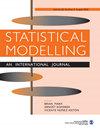抖动对基于栅格和距离的人口与健康调查数据地理统计分析的影响
IF 1.2
4区 数学
Q2 STATISTICS & PROBABILITY
引用次数: 0
摘要
根据人口与健康调查(DHS)项目的住户调查,精细的协变量栅格通常被用于绘制人口与健康指标的地理统计模型。然而,地理统计分析忽略了一个事实,即人口与健康调查中的 GPS 坐标是出于保护隐私的目的而抖动的。我们证明了考虑这种抖动的必要性,并提出了一种可常规应用的高效计算方法。我们使用新方法,以 2018 年人口与健康调查为基础,分析了 2018 年尼日利亚 20-49 岁女性完成中等教育的普及率。分析表明,与我们忽略抖动时相比,空间范围和固定效应的估计值发生了很大变化。通过模拟数据集的模拟研究,我们证明考虑抖动可减少协变量估计系数的衰减,并改善预测结果。结果还表明,在观测位置周围的窗口中平均协变量值的常见方法并不能带来与考虑抖动相同的改进。本文章由计算机程序翻译,如有差异,请以英文原文为准。
Impact of jittering on raster- and distance-based geostatistical analyses of DHS data
Fine-scale covariate rasters are routinely used in geostatistical models for mapping demographic and health indicators based on household surveys from the Demographic and Health Surveys (DHS) program. However, the geostatistical analyses ignore the fact that GPS coordinates in DHS surveys are jittered for privacy purposes. We demonstrate the need to account for this jittering, and we propose a computationally efficient approach that can be routinely applied. We use the new method to analyse the prevalence of completion of secondary education for 20-49 year old women in Nigeria in 2018 based on the 2018 DHS survey. The analysis demonstrates substantial changes in the estimates of spatial range and fixed effects compared to when we ignore jittering. Through a simulation study that mimics the dataset, we demonstrate that accounting for jittering reduces attenuation in the estimated coefficients for covariates and improves predictions. The results also show that the common approach of averaging covariate values in windows around the observed locations does not lead to the same improvements as accounting for jittering.
求助全文
通过发布文献求助,成功后即可免费获取论文全文。
去求助
来源期刊

Statistical Modelling
数学-统计学与概率论
CiteScore
2.20
自引率
0.00%
发文量
16
审稿时长
>12 weeks
期刊介绍:
The primary aim of the journal is to publish original and high-quality articles that recognize statistical modelling as the general framework for the application of statistical ideas. Submissions must reflect important developments, extensions, and applications in statistical modelling. The journal also encourages submissions that describe scientifically interesting, complex or novel statistical modelling aspects from a wide diversity of disciplines, and submissions that embrace the diversity of applied statistical modelling.
 求助内容:
求助内容: 应助结果提醒方式:
应助结果提醒方式:


